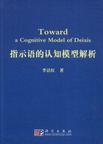指示语的认知模型解析
2008-5
科学出版社
李洁红
137
无
语言中普遍存在的指示现象是语言学研究的重要课题。传统研究已经对指示现象进行了非常详细的描写,但仍然缺乏系统的理论框架。近几年指示语的认知研究虽然开辟了新的途径,但这些研究大多侧重个别指示现象,或者只强调指示语的经验解释。基于此,本研究建立了一个指示语认知模型,形象地描写指示的认知过程并据此揭示指示现象的本质。,该模型的建立不仅能发展指示理论,同时为人工智能理解指示语提供准备,具有理论意义和实用价值。 通过分析形成指示现象的认知机制,即视角及视角转移、概念隐喻和认识模式,我们将指示语的认知模型定义为一个以说话人为原点,以空间、时间和情态为轴的笛卡儿坐标系,用矢量描写指示语在该系统中的语义结构。该模型涉及人称指示、空间指示、时间指示和情态指示,能够最大限度地涵盖指示现象。模型的结构和使用也以认知机制为基础,其中视角、空间隐喻和认识模式为模型基本结构的建立提供依据,而视角转移使模型以动态的方式解决问题。此外,概念隐喻使该模型的各层面存在关联,也使该模型成为一个有机系统。矢量的体现和运行也有其感知和神经生理基础,视角和远近空间差异决定矢量的方向和大小,而视角转移可以导致矢量的迁移、放大和缩小。这样一个以认知为基础的模型能够形象地模拟指示语在经验世界的产生和应用,清楚地展现指示语在言语交际中的认知“路径”。 指示语的认知模型采用几何空间模拟指示语的概念化过程。本研究以传统研究中的典型指示语和日常用语中的指示语为语料,用矢量空间描写其语义结构。人称代词和指示代词定位于物理空间轴,它们的定位存在某种内在关系。呼语和移情指示则定位于心理空间轴。在时间轴和情态轴上识别事件,已知现实由过去时间和现在时间表达,潜在现实由将来时间和情态动词表达。借助该模型,现在、过去和将来时态的一些异常用法可以得到合理的解释。同时,该模型中协调系统的整体移动为移动动词、历史现在时和条件句等用法提供了充分的说明。
AcknowledgementsAbstract摘要List of FiguresChapter 1 Introduction11.1 Significance of the Study1.2 Research Objectives1.3 Research Methodology1.4 Organization of the BookChapter 2 Traditional Studies on Deixis2.1 Main Contributions Made by Philosophers and Linguists2.2 General Description of Deixis2.2.1Characteristics ofDeixis2.2.2 Definition of Deixis2.2.3Semantic Features OfDeixis2.2.4Classification of Deixis2.2.5 Usages ofDeixis2.3Main Problems in the Traditional Studies2.3.1 Lack OfNature.based Definition2.3.2 Deictic Projection2.3.3 Vague Relations between Categories ofDeixis2.4 SummaryChapter 3 Cognitive Approaches to Deixis..203.1 Introduction:Epistemic Basis of Deixis3.2 Epistemic Grounding3.2.1 Grounding Elements and Their Deictic Nature3.2.2 Types ofDeictic Expressions3.2.3 Cognitive Motivations ofDeictic Expressions3.3 Mental Spaces3.3.1Basic Ideas ofMental Spaces3.3.2 Application ofMental Spaces in the Study ofDeixis3.4 Vantage Point and Field of Vision3.5 SummaryChapter 4 Toward a Cognitive Model of Deixis4.1 Introduction:a Model Based on Situation and Cognition4.2 Cognitive Motivations for the Model4.2.1 Viewpoint and Viewpoint Shift4.2.2 Conceptual Metaphor4.2.3 Epistemic Models4.3 Structure of the Model4.3.1 A Three.axis Coordinate System4.3.2 Vector and Vector Space4.4 SummaryChapter 5 Semantic Configuration of Deixis in the Model5.1 Person Deixis5.1.1 Person Deixis on the Space Axis5.1.2 Deictic Projection between Persons5.2 Space Deixis5.2.1 Proximal/distal Relation on the Space Axis5.2.2Verbs of Morion5.2.3 Prepositions with Deictic Use5.3 Time Deixis5.3.1 Time Deictic Terms5.3.2 Tense5.4 Modal Deixis5.4.1 Degrees ofEpistemic Distance5.4.2Real Conditions and Unreal Conditions5.5 SummaryChapter 6 Reconsideration of Deixis from the Perspective of Cognition6.1 Definition and Semantic Features6.2 Subjectivity and Grammatical Features6.3 Deixis as a System and Its Model Structure6.4 SummaryChapter 7 Conclusions1237.1 Summary of the Study7.2 Major Findings of the Study7.3 Limitations and Suggestions for Further StudiesBibliographyList of Figures3.1 Field of vision:participant roles j and you3.2 Field of vision:participant roles with two perspectives3.3 Field of vision:demonstratives this and that3.4 Field of vision:tenses4.1 Structure of the cognitive model of deixis605.1 Personal pronouns and vocatives5.2 j is transferred into you5.3 Third person is transferred into we5.4 Demonstratives on the physical and psychological space axes5.5 Verbs of motion5.6 Configuration ofcoming5.7 Came with home base as reference point5.8 Come in a hypothetical space5.9 Configuration of infront of5.10 Prototypical time deictic terms5.11 Configuration ofyesterday with other reference point5.12 Present tense.past tense and future tense5.13 Past future.5.14 Historical present and present tense in a hypothetical space5.15 Present perfect5.16 Past perfect5.17 Future perfect5.18 Epistemic distance of modals5.19 Real and unreal conditions5.20 Unreal condition in the present5.21 Unreal condition in the past5.22 Unreal condition in the futuretem model of deixis
1.1 Significance of the Study Diesis,as a universal language phenomenon: is an important topic in linguistic studies.From the end of the 19th century:philoso-phers and semanticists did intermittent researches on diesis.Until1934,Bailers now-here-I system of subjective orientation laid the theoretical foundations for the study of diesis.In the subsequent1950s and 1960s,diesis jumped into the focus of pragmatics and Theo-recital linguistics.From the 1970s to the 1990s,a more comprehensive study of diesis was made by Lyons,Fillmore and Levin son:etc.These studies provide a considerably detailed description of diesis in its characteristics : definition: semantic feature,categorization and usage: but scatter in different linguists’academic papers and works without being fully developed in theoretical depth.Till now:there are still number of problems unsolved in de~~is,among which lack of na-ture-based definition: deictic projection: and vague relations between categories of delis are most obvious.These problems are greatly dueto the underdeveloped theoretical framework of deixis. With the development of cognitive linguistics in recent years,some linguists adopted cognitive approaches to delis,including epistemic grounding: mental spaces,and field of vision.

无